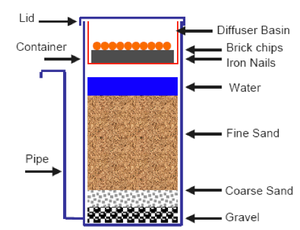
Problem being addressed[edit | edit source]
Contaminated water sources are often the cause for diarrheal diseases. Inhabitants in low-resource settings often lack ready access to clean water and are most susceptible to diseases caused by contaminated water. In addition, water supplies can be contaminated with high levels of arsenic. For example, in eastern Nepal, 9% of the 268 water samples contained arsenic above the WHO guidelines.
Detailed description of the solution[edit | edit source]
The Arsenic Bio-sand Filter (ABF) removes arsenic, iron, and bacterial contamination without using any chemicals. The arsenic unit removes arsenic by oxidation/reduction, precipitation, and adsorption. The pathogen removal unit contains sand and gravel layers that remove deadly pathogens. The ABF unit can process 15 to 30 liters of water per hour.
Designed by[edit | edit source]
- Design: This filter was developed by researchers at Massachusetts Institute of Technology (MIT), Environment and Public Health Organization (ENPHO) of Nepal, and Rural Water Supply and Sanitation Support Programme (RWSSSP) of Nepal.
When and where it was tested/implemented[edit | edit source]
Studies conducted in Nepal so far have shown that the Kanchan Arsenic Filter is effective in removing arsenic, iron as well as bacteria together. The users liked the high flow rate, simple operation, minimal maintenance, as well as the clean-looking and good-tasting water coming out of the filters. They think the filter is a durable, permanent solution to their drinking water problems.
Funding Source[edit | edit source]
This project received a $115,000 award from the World Bank Development Marketplace Global Competition.
References[edit | edit source]
Peer-reviewed publication[edit | edit source]
Baker, D. L., Duke, W. F., Mazumder, A. R., & Nordin, R. (2006). Performance of bsf in haiti: A field study of 107 households. Rural and Remote Health, 6(570). PDF available here.
Baumgartner, J., Murcott, S., & Ezzati, M. (2007). Effects of operating conditions on the bacterial removal of two household drinking-water filters . : Environmental Research Letters, 2. PDF available here.
Stauber, C. E., Elliot, M. H., Koksal, F., Ortiz, G. M., Liang, K., DiGiano, F. A., & Sobsey, M. D. (2006). Characterization of the bsf for microbial reductions- lab and field conditions. : Water Science & Technology, 54(3), 1-7. Link available here.
Internally generated reports[edit | edit source]
Ghimire, B. (n.d.). Kanchantm arsenic filter: Can iron and arsenic particles migrate through the sand layer?. Manuscript submitted for publication, Kathmandu University, Nepal. PDF available here.
Thomson, E. A. (2004, March 9). Mit filter cleans nepalese drinking water. Link available here.
Externally generated reports[edit | edit source]
Kanchan arsenic filter. (2010, July 26). Link available here.
Murcott, S. (2010). The kanchan™ arsenic filter. Link available here.